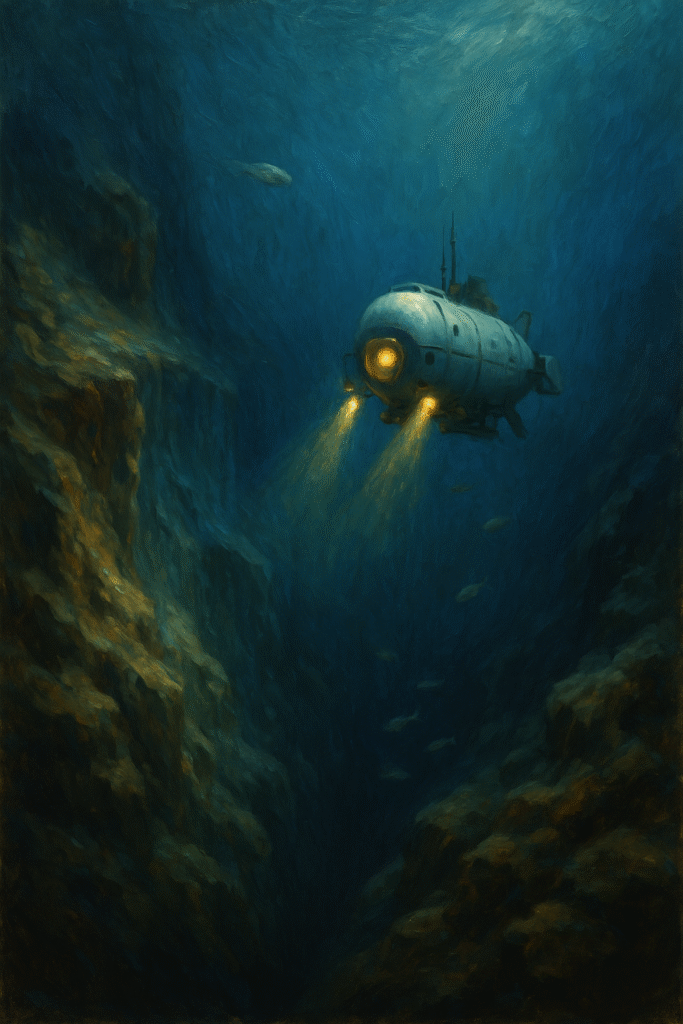The Mariana Trench, located in the western Pacific Ocean, is renowned as the deepest point on Earth, reaching profound depths that challenge our understanding of both geology and marine life. Positioned east of the Mariana Islands, the trench plunges approximately 36,000 feet (about 11,000 meters) into the ocean and is often celebrated for its geological significance and rich biodiversity. This article delves into its historical exploration, current research, and the unique ecosystems that thrive within this underwater abyss.
Introduction to the Mariana Trench and Its Location
The Mariana Trench is situated between the Mariana Islands and the Philippines, and it boasts a length of over 1,550 miles (2,500 kilometers) and a width of just over 43 miles (69 kilometers). The trench’s maximum known depth is called the Challenger Deep, named after the HMS Challenger expedition that first measured it in the 19th century. This area is considered one of the most inhospitable on the planet due to the immense pressure, low temperatures, and absence of light, creating conditions unimaginable to most life forms.
The geographical makeup of the trench presents a series of underwater features, including deep abyssal plains, underwater volcanoes, and seismic features like fault lines. The trench forms as a result of subduction, where one tectonic plate slides beneath another, in this case, the Pacific Plate beneath the Mariana Plate. This geological process not only creates these extreme depths but also leads to significant geological phenomena, including earthquakes and volcanic activity in the surrounding region.
Historical Context of Exploration and Key Discoveries
Understanding the Mariana Trench has been a journey of scientific curiosity spanning over a century. Early investigations date back to 1875 with the HMS Challenger expedition, which provided the first definitive measurements of the trench’s depth. Over the years, several key discoveries have shaped our understanding of this submarine world:
- HMS Challenger Expedition (1875): The first scientific voyage that accurately measured the depth of the trench using the echo-sounding technique. They recorded a depth of 5.5 miles (approximately 8,850 meters) at Challenger Deep.
- The Trieste Deep-Diving Expedition (1960): This voyage marked a significant milestone when Jacques Piccard and Don Walsh descended into the Challenger Deep in the bathyscaphe Trieste, reaching a depth of about 35,814 feet (10,916 meters). Their observations provided unparalleled insights into the trench’s environment.
- Deepsea Challenger (2012): Filmmaker James Cameron made headlines by completing a solo dive to the trench’s deepest point, collecting valuable data and video footage, which reignited interest in deep-sea exploration.
- Recent Research: As of 2021, researchers utilizing remotely operated vehicles (ROVs) and autonomous underwater vehicles (AUVs) have uncovered previously unknown species and mineral deposits, pushing the boundaries of our understanding further.
Each expedition has deepened our appreciation for the trench, revealing both its complexities and its vital role in Earth’s ecological and geological processes.
Current Research and Expeditions, Including Technological Advancements
Technological advancements have revolutionized the way we explore the depths of the Mariana Trench. Today, the use of sophisticated submersibles, ROVs, and AUVs allows for detailed exploration without the immediate danger faced by human divers. Recent innovations include:
- ROVs: These unmanned vehicles can operate at extreme depths, equipped with cameras and sampling tools that are critical for data collection. Notable examples include the remotely operated vehicle Nereus and the Limiting Factor, which was built by Triton Submarines and has been used for various exploratory missions.
- Mapping Technologies: Advances in sonar technology enable researchers to create high-resolution maps of the trench’s landscape, providing deeper insights into its geological structures and potential biodiversity hotspots.
- Environmental DNA (eDNA): Scientists now utilize eDNA techniques to detect species presence in the water column by analyzing DNA left behind by organisms, which is vital for understanding biodiversity in such remote areas.
Current expeditions continue to reveal astonishing findings. For instance, during a 2020 expedition titled Mission Deepsea, researchers discovered new types of organisms in the trench, including unique microbial species that thrive in extreme conditions. Additionally, studies from 2023 highlight the potential for bioprospecting in the trench, searching for novel compounds that can benefit medicine and biotechnology.
Ecosystems and Species Found in the Trench
The Mariana Trench is an ecological enigma, hosting a range of unique ecosystems, each supporting life forms that have adapted to extreme conditions. From the depths of the Challenger Deep to the surrounding areas, diverse species inhabit these darkened waters, showcasing nature’s resilience:
- Microbial Life: Bacteria and archaea are abundant in the trench, often forming biofilms on the trench’s rocky surfaces. These microorganisms play a pivotal role in nutrient cycling within the trench ecosystem.
- Amphipods: One of the most well-known organisms found in the trench is the amphipod halicephalobus megalops, often referred to as the “deep-sea snailfish.” Notably, a specimen was discovered at the record-setting depth of 36,000 feet, showcasing adaptation mechanisms to high pressure.
- Polychaete Worms: Organisms like Osedax, known as bone-eating worms, have been identified feasting on the remains of dead marine life that sink to the ocean floor, playing a critical role in the trench’s ecological dynamics.
- Giant Squid and Other Cephalopods: Additionally, the trench is thought to be home to elusive cephalopods, including giant squids, which are rarely observed but contribute significantly to the complexity of the deep-sea food web.
The ecosystems within the Mariana Trench underscore the importance of conservation efforts and further expeditions required to document and understand these organisms’ roles within the broader marine ecosystem.
The Trench’s Relevance to Understanding Earth’s Geology and Marine Life
The Mariana Trench serves as a natural laboratory for understanding the processes that shape our planet’s geology and marine biodiversity. It provides crucial insights into:
- Plate Tectonics: As the deepest point on Earth, the trench allows geologists to study the intricate workings of plate tectonics, including subduction processes, which are fundamental to understanding earthquakes and volcanic activity.
- Extreme Environments: The unique organisms that exist in the trench are potential models for understanding extremophiles, which can inform astrobiology and the search for life beyond Earth, especially in other extreme environments like Mars or icy moons.
- Biodiversity Hotspots: Recognizing and protecting the unique ecosystems within the trench may illuminate the broader implications of biodiversity loss in the face of climate change and human activities.
As our exploration of the Mariana Trench continues to evolve, it remains a beacon of scientific inquiry that not only feeds our curiosity but also enriches our understanding of life’s tenacity in the most extreme environments.
Conclusion
The Mariana Trench stands as a symbol of the mysteries still held by our planet. Its vastness and the life it nurtures capture the imagination and spark a profound sense of curiosity among scientists and enthusiasts alike. As humanity pushes the boundaries of exploration, the trench will undoubtedly continue to reveal its secrets, underscoring the critical need to balance our technological pursuits with environmental stewardship. By doing so, we can ensure that this underwater realm remains a place of discovery for generations to come.
FAQ Section
What is the Mariana Trench?
The Mariana Trench is the deepest known point on Earth, located in the Pacific Ocean, with its maximum depth called the Challenger Deep, approximately 36,000 feet deep.
How was the Mariana Trench discovered?
It was first explored during the HMS Challenger expedition in 1875, which used sonar technology to measure its depth.
What types of organisms live in the Mariana Trench?
Unique organisms such as amphipods, polychaete worms, and various microbial species exist at different depths, showcasing adaptations to extreme conditions.
Why is the research on the Mariana Trench important?
Research on the trench contributes to our understanding of geological processes, biodiversity, and the potential for life in extreme environments, with implications for astrobiology.
What technological advancements aid exploration of the Mariana Trench?
Advancements include remotely operated vehicles (ROVs), autonomous underwater vehicles (AUVs), and enhanced sonar mapping techniques, all of which improve our ability to study deep-sea environments.
How do scientists study life in the trench?
Scientists utilize techniques like environmental DNA (eDNA) analysis, deep-sea submersibles, and ROVs to collect samples and data to understand the trench’s biodiversity.


